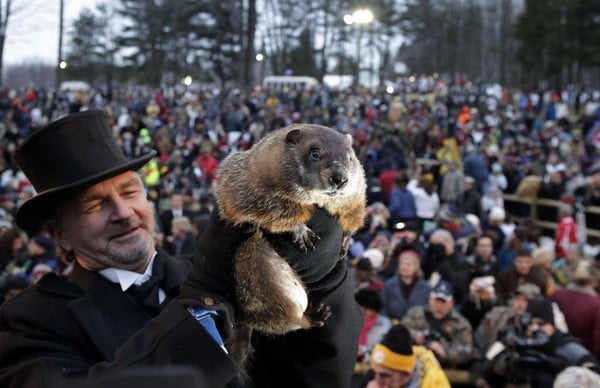THE GREAT GROUNDHOG’S DAY CONSPIRACY
By Fred Bortz ([email protected])
Many years ago in the Allegheny Mountain town of Punxsutawney PA, a secret committee met, led by Ima Merchant, the head of the local chamber of commerce. Town statistician C. P. Adderly and P. R. Mann, head of a local advertising firm, were also in attendance.
After calling the meeting to order, Merchant announced the reason for the conference. “The local economy is suffering, especially in winter,” she declared. “Does anyone have any ideas of how to change that?”
The town librarian, Linda U. Booker, had an idea. “We have a list of obscure holidays that we use to draw our regular patrons and their friends. Maybe we can find one that will bring in some tourists. Let me take a look.” She quickly suggested February 2, Groundhog Day, the midpoint of winter.
Adderly, who doubled as the local weatherman, checked his record books. He calculated that one year in five had an early spring. “I’ve got it!” he announced triumphantly. “Let’s call ourselves the official home of Groundhog’s Day. We can have a ceremony each year at Gobbler’s Knob, invite the newspapers, and have them print the news from Punxsutawney Phil. If he sees his shadow, it means six more weeks of winter. If not, an early spring is on the way.”
Mann was enthusiastic about the idea. “I know just how to publicize it. But there’s just one problem. What if Phil is wrong?”
“That’s where statistics come in,” said Adderly. “We’ll start by predicting more winter for the first few years, and we’ll probably be right. One year out of five, we’ll predict an early spring. Since it’s really hard to tell the difference most years, we can claim that Phil is right. People will be having so much fun that they won’t bother to check.”
Adderly went on to include some math, just in case some newspaper tries to dispute Phil’s accuracy. “If Phil predicts more winter 80 percent of the time, and we get more winter 80 percent of those years, he will be correct 64 percent (80 percent of 80 percent) of the years. Of the remaining 20 percent of the years when he predicts an early spring, he will be right 20 percent of those years–not counting the years we claim an early spring even if it isn’t–that adds another four percent to the correct prediction times. That means 68 percent, or more than two years out of three, Phil will be right.”
“Wow!” exclaimed Merchant. “Even with totally random guessing, Phil will do better than the 50 percent most people think would be chance. ”
“Yes,” added Mayor Paula Tician. Just like Abe Lincoln said, “You can fool some of the people all of the time, and all of the people some of the time. But if you fool enough of the people enough of the time, you can get rich.”
And so, the modern Groundhog’s Day tradition was born.

So Groundhogs day is fake news?!